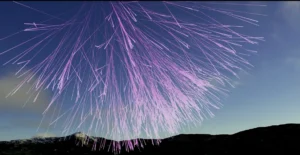The James Webb Space Telescope has shown the earliest galaxies of the universe for the first time, more than 13 billion years ago.
We have always been looking at the past by observing the deep universe through more and more advanced telescopes. It has been made possible by the researchers of at the Niels Bohr Institute at the University of Copenhagen. The University has become the first to make such a discovery.
Using the James Webb Space Telescope researchers were able to see light signals from large amounts of gas that accumulate and accrete onto a mini-galaxy in the process of formation. Although this is the process of formation according to the computer simulations and theories but it has never been seen.
Assistant Professor Kasper Elm Heintz from the Niels Bohr Institute, who led the new study said:
You could say that these are the first ‘direct’ images of galaxy formation that we’ve ever seen. Whereas the James Webb has previously shown us early galaxies at later stages of evolution, here we witness their very birth, and thus, the construction of the first star systems in the universe
How earliest galaxies was observed?
It was made possible by a transition known as Lyman-alpha transition. The neutral gas surrounding the forming galaxies absorbs the light from them. The researches by using a sophisticated model which measures the light, were able to distinguish light from the newly formed galaxies and the light from other gas. It was possible due to the incredibly sensitive infrared spectrograph capabilities of the James Webb Space Telescope.

Galaxies were formed shortly after the Big Bang
According to the researchers these there galaxies as shown in the picture was formed around 400 to 600 million years after the Big Bang. This time seems to be a long time but approximately three to four percent of the 13.8 billion years old Universe.
Today universe seems to be transparent and as such we are able to see the stars and the deep space. However, just after the Big Bang, the universe had an enormous gas of hydrogen atoms that made it opaque.
According to Associate Professor Darach Watson:
During the few hundred million years after the Big Bang, the first stars formed, before stars and gas began to coalesce into galaxies. This is the process that we see the beginning of in our observations
The energy and the light from the first galaxies passed through the mist of hydrogen gas. This time is known as Epoch of Reionization in the time of the universe.
The James Webb Space Telescope’s incredible infrared vision captured these large amounts of hydrogen gas. In the history of scientific research this is the most distant measurement ever done to date.
Simone Vejlgaard, a PhD student from Cosmic Dawn Center at the University of Copenhagen’s Niels Bohr Institute says
“For now, this is about mapping our new observations of galaxies being formed in even greater detail than before. At the same time, we are constantly trying to push the limit of how far out into the universe we can see. So, perhaps we’ll reach even further”
Gabriel Brammer Associate Professor at University of Copenhagen’s Niels Bohr Institute says
“One of the most fundamental questions that we humans have always asked is: ‘Where do we come from?’. Here, we piece together a bit more of the answer by shedding light on the moment that some of the universe’s first structures were created. It is a process that we’ll investigate further, until hopefully, we are able to fit even more pieces of the puzzle together”
Reference: science.ku.dk








